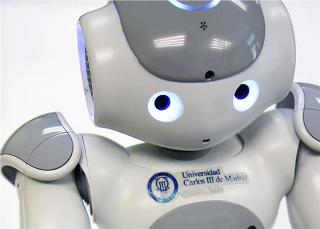Apr 21 2015
In collaboration with other national institutions, researchers at Universidad Carlos III de Madrid (UC3M) are designing a new therapeutic tool for motor rehabilitation for children. In this project, an interactive social therapist robot, which is totally autonomous, is able to perceive patients’ reactions and determine if they are doing their exercises correctly.
 uc3m
uc3m
This advance, which had been developed as part of the scientific project known as Therapist, proposes a therapeutic method that is enlivened by a robot that looks like a toy to avoid the kind of discouragement that often impedes youngsters’ recovery. So far, more than one hundred children have evaluated the social abilities of the robot, and some children with motor difficulties have tried this therapy. Both the children and their parents, as well as the medical staff who work with them, have noted that this makes the activity more fun and attractive for the patients and that the robot is an excellent tool for improving the degree to which patients’ correctly follow their rehabilitation treatment, as well as improving the evaluation process, according to an article on this development that was recently published in the journal Revista Iberoamericana de Automática e Informática Industrial.
During the process of this research, in which UC3M, la Universidad de Málaga, la Universidad de Extremadura and el Hospital Universitario Virgen del Rocío de Sevilla have all participated, the humanoid robot NAO, which is 58 centimeters high and weighs just over four kilos, was converted into a kind of personal therapist. This is how it is described by the head of the project from the research group on Planning and Learning (Planificación y Aprendizaje - PLG) within UC3M’s Computer Science Department, Fernando Fernández Rebollo; he explains that the idea is to create “a robot that doesn’t seem like a robot, which seems alive to the children, and can socially interact with them.” The second goal of the project is to collaborate with the hospitals’ medical rehabilitation services in defining therapies where this device could be used. There is no physical contact between the robot and the patient at any time, nor is there any risk to the child, the scientists assure.
Advantage of the system
“The main benefit is that the children see the robot as a friend; they like playing with it and they become uninhibited,” assures one of the researchers from he PLG group, José Carlos Pulido. That was the experience of the patients in the pediatric unit at the Hospital Universitario Virgen del Rocío, who responded affirmatively to the “Do you want to play with me?” that this robotic therapist asked to start the sessions. After asking the questions, the robot indicates the rehabilitation exercises (a sequence of postures that the child must imitate), carrying them out itself thanks to its articulated body. When a child doesn’t carry out the positions correctly, the robot indicates this visually, by the color of its eyes and, using its voice and body movements, shows the patient how to do the exercise correctly.
The work done by UC3M is focused on planning tasks and automated learning, something that “gives the robot the ability to decide which actions it wants to carry out at any given moment,” explains Fernández Rebollo, as well as “adapt to the characteristics of the patient and the rehabilitation session that is underway.” He also points out that this “control architecture”, called Robocog, can be applied to other robotic therapists such as Ursus, which la Universidad de Extremadura is currently working on as part of this consortium. In addition, these robotic physical therapists will be fine-tuning their performance thanks to the algorithms that Universidad de Málaga is working on and which, as José Carlos González, one of the other PLG researchers at UC3M who is working on this project, notes, will allow the robot to recognize the child’s gestures using a camera; it will be able to recognize when the child is smiling, getting angry or having difficulty with an exercise.
Desarrollan un terapeuta robótico para niños
This robotic therapist will become a reality and could, within a few years, even enliven rehabilitation processes for children with pathologies like cerebral palsy. For now, the researchers point out that there is still work to be done defining the metrics for accurately evaluating the degree of success of the new rehabilitation therapy and determining the degree of interaction with the patient that this robotic physical therapist might reach; its contribution to the evaluation and monitoring of the therapies must also be determined.
The Therapist project has been carried out in part, thanks to the support of the Ministry of the Economy and Competitiveness (Ministerio de Economía y Competitividad - MINECO) and FEDER funds under the coordinated project TIN2012-38079, in which the Universidades de Extremadura, Málaga and Carlos III de Madrid have participated, as has the Hospital Universitario Virgen del Rocío de Sevilla.